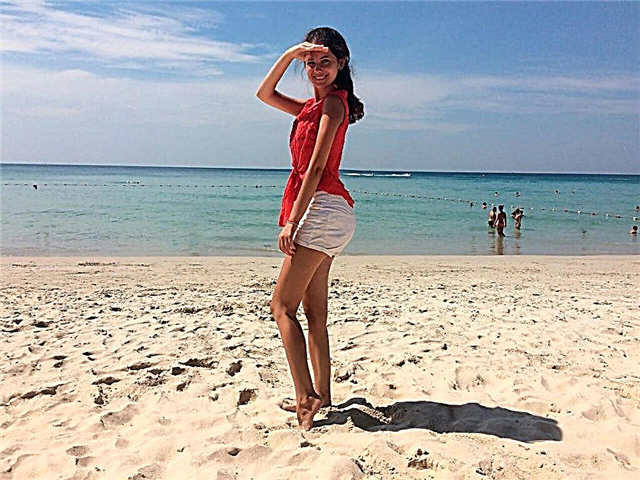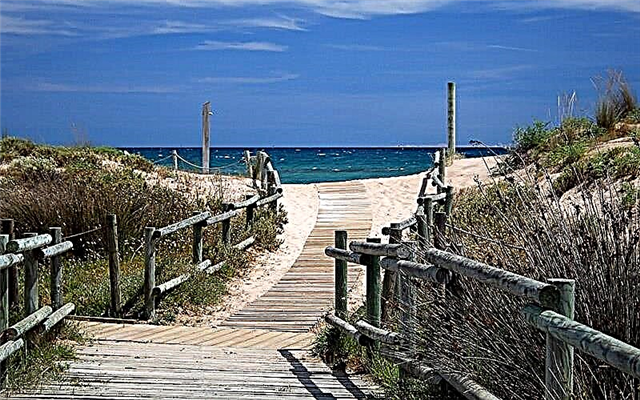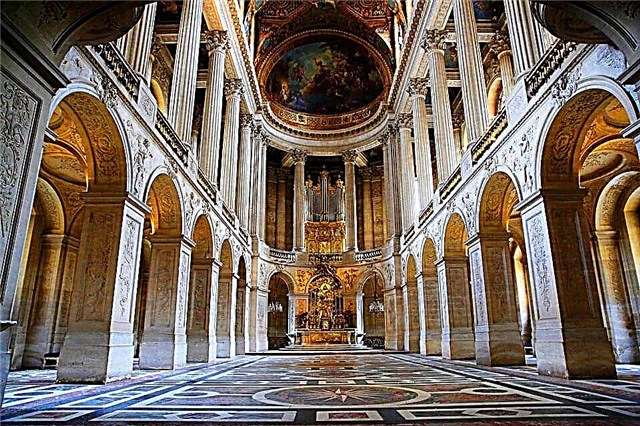The sights of Versailles attract tourists here at any time of the year. This is not surprising: the ensemble is located just 20 km from Paris. You can get here in less than an hour. And upon entering the park, visitors feel embarrassed: there are so many beauties next to each other. But once you concentrate, correctly draw up a route, and everything immediately falls into place. Moving from one object to another, it is realistic to get an idea of how the last monarchs of France lived. Or maybe feel like one of them. We will tell you what you can see in Versailles in one day on your own.
Palace of Versailles

There is no government residence in the world yet superior in luxury to the Palace of Versailles. And it all began with the fact that the king of France, Louis 13, liked the hunting grounds around the village of Versailles, where he came to hunt in the possession of a native of Florence, Gondi. Louis immediately ordered to rebuild a hunting lodge nearby. After the death of Gondi, all the surrounding lands began to belong to the crown. The hunting lodge was slightly expanded and significantly strengthened, after which it began to resemble a small fortress. It was here that Louis 14 lived from the age of 5 until the beginning of his official reign.

Louis was afraid to live in the capital, preferred a perfectly fortified country residence. Its position was extremely successful: only 20 km to Paris. While at a distance, the king kept the aristocrats under surveillance at the same time. But the issues of prestige are not alien to Louis 14 either: he understood that the grandeur of the palace would allow him to raise the authority of his own subjects and neighbors, so money from the treasury was not spared to equip Versailles.
The palace was expanded, and the area around it was landscaped, a garden and park ensemble was created. After the arrest of the Minister of Finance, Fouquet, all the confiscated fortune went into action, and the architects Leveaux, Lebrun, Le Nôtre, who worked on the Fouquet palace, were instructed to complete the construction of the royal residence: the monarch was struck by the luxury of the residence of the disgraced minister. Even the wars waged by France did not serve as an obstacle to the work: construction was only suspended and then continued.
The descendants of Louis 14 also continued to improve the palace, but the scale was already completely different. The work mainly concerned interior alterations and landscape design. The Palace of Versailles is the central part of the city, where the aristocrats of France were forced to settle in order to keep up with the king. And each built more or less lavish apartments that now adorn the suburbs of Paris.
Mirror gallery

A unique hall during the reign of the Sun King. This splendid gallery was created to commemorate the victories of the monarch:
- the ceiling is decorated with 30 paintings reflecting the victories in wars and successes in the economic strengthening of France;
- huge mirrors - a symbol of the wealth of the state and the crown, mirrors repeat the shape of window openings and are located in pairs opposite; only here, in the time of Louis 14, ladies and gentlemen saw their reflection in full growth;
- crossing length - 73 m; along the entire length, the gallery is decorated with lilies (a symbol of the reigning house), images of roosters (a sign of the kingdom), drawings of the sun (personal coat of arms of King Louis 14).
But the Sun King would not have been himself if he had not pursued quite prosaic goals: the richly decorated gallery was intended for a comfortable transition of the royal family from the palace to the church. Even in France, the weather is unpleasant. And all this luxury served for the good of the state: receptions were held here, gorgeous balls were held, agreements that were most important for the state were signed. Part of the rich interior was removed at various times and melted down for the needs of the French army. But even today, the grandeur of the Mirror Gallery amazes tourists. And the French government continues to use this part of Versailles for state receptions.
Royal apartments

This is part of the Versailles castle of 6, which belonged personally to the Sun King. The value of the apartments is that the interiors have been preserved almost completely. And today tourists willingly inspect the premises where the great monarch once lived.
All rooms are interconnected, one replaces the other:
- The first hall is a loggia. Actually, this is a semblance of a room courting the chambers of Louis 14. But even this small room is luxuriously decorated with marble.
- It is impossible to immediately get into the private quarters of the Sun King: you will have to overcome the guard room. The personal security of the monarch was in it around the clock. This room is very modest, the walls are painted white.
- The next room is the beginning of the apartment. In it the king dined and rested. On the walls you can see paintings of famous battle scenes. The authors of the paintings are Courtois and Parrosel.
- The Bullseye Hall is the most beautiful room in the apartment. The room is named so because of the window on the south side, which is shaped like a hoofed eye. There are many huge mirrors (a huge rarity in the days of the Sun King); Veronese canvases are hung on the walls. The hall is decorated with a grate depicting dancing boys.
- The bedroom is an important room for monarchs. Here they not only slept, but also conducted private negotiations, received ambassadors. It is not surprising that the room is richly decorated: curtains and tapestries, paintings by the greats Van Dyck, Caravaggio, Domenichino, Reni. The Sun King died in this room.
- The last room is the Royal Council Hall. The interiors reflect the purpose of the room. There is a bust of Alexander the Great, vases with images of Venus and Mars. On the walls there are wood carvings.

To view the apartments, it is worth buying a single ticket: this is part of the excursion program.
Chapels

During the reign of the Sun King, the construction of chapels was not only fashionable, but also a profitable enterprise: if the customer immediately paid for the work, then later he was exempted from property tax.
At different times, 5 chapels were built:
- The first chapel was built by the father of the Sun King - King Louis 13. It was an unpresentable structure made of wood with a height of 2 floors. It was broken during the construction of the Tethys grotto.
- The second customer was the Sun King himself. It was erected immediately after the completion of the new part of the palace. At first, the chapel was used by the royal family, and then court hearings were held in it. As the park expanded, space was required for outbuildings, so this chapel was also broken down to build a barracks for the guards.
- Louis 14, next to the second, erected another one: for himself and his family members, and later for the royal court. But soon this chapel also ceased to suit the monarch: it was too cramped and uncomfortable. The fate of this building is more prosperous than that of its predecessors: it was converted into a coronation hall.
- After the completion of work on the 3rd wing of the building, the 4th chapel was also built. Traditionally, it took the Tethys grotto to be demolished. This chapel liked the royal family: it was used for its intended purpose until the beginning of the 18th century.
- The last chapel is an example of long-term construction: work began in 1689 and finished in 1798. True, there was a break for the war. Completed the construction of Kott. The horizontal lines of the building prevail over the vertical ones, which is why some historians call St. Louis Chapel a huge hearse. However, the building is richly decorated on the outside and the luxurious interiors are impressive.
The chapel services were held until the end of the 19th century. Today it is used by the government to meet with officials. The chapel has excellent acoustics: concerts are regularly held here.
Church of the Virgin

Notre Dame Versailles is a parish church that simultaneously served as the home church of the owners of the palace. Louis 14, Louis 15 and Louis 16 were married in it, received communion and a burial service. The records of the wedding, birth and death of members of the royal family were made in the parish books of the cathedral. The author of the project is Jules Hardouin-Mansart. He designed the building in the fashionable (at the time) French classicism style. The construction proceeded quickly: from the laying of the first stone to the consecration of the cathedral, it took about 2 years.
But when you look at Notre Dame Versailles, you get a strange impression: the cathedral looks too pressed to the ground. This is not an architect's mistake: Louis 14 introduced a ban on the height of the surrounding buildings, so as not to spoil the panorama that opens from the windows of his residence. In the 18th, 19th and 20th centuries, restoration work was carried out, new details of facades and interiors were added. The last alteration concerned the main altar: it was replaced in 1999.
The greenhouse of Versailles

The Sun King wanted to lead in everything, including botany. On his behalf, the gardeners kept a huge collection of citrus fruits, which (as in their homeland) simultaneously bloomed and bore fruit. For this, a specially developed system of watering, pinching and feeding was used. A special achievement was that the plants were kept in tubs of soil and placed in a greenhouse only during the cold season. In the spring and summer months, oranges were exhibited in the garden (in the parterre).
The building was built very competently: light penetrates through the huge south windows, the ceiling has a vaulted profile. Everything is done in order to accumulate the incoming heat. But the greenhouse was not only a fashionable addition to the park: here the troupe of the theater of Queen Marie Antoinette gave performances while the construction of the permanent premises was underway. And in the days of the commune, the greenhouse was used to keep prisoners.
When the cold came, the prisoners were executed in order (according to tradition) to bring tubs of oranges inside. Today in the greenhouse you can see a huge pool of marble. This is all that remains of the Bath Pavilion. An octagon bath with a depth of 1 m and a facet length of 8 m was purchased for the palace. And she only fit in the greenhouse. Presumably, the Sun King rinsed his tired feet in the pool when he returned from hunting.
Apollo fountain

On the site of the pool where the fountain is located, a pond was dug during the first builder of the residence (Louis 13). It was called swan. It is unknown whether swans were found here or not. But for the plot of the fountain, the former name came in handy: these winged creatures were part of the retinue of Apollo's mother. God rides in a chariot across the sky, repeating the path of the heavenly body: after all, it is Apollo who illuminates the earth. But for the sake of the successful construction of the composition, the movement of the cart goes in a completely different direction.
But ripples on the water, sunlight create a full sense of movement. Apollo leads a chariot along a large canal, so the movement of the god is endless. The fountain jets form a lily: the heraldic symbol of the monarchs of France. The central stream breaks out by 20 m, and the side ones - by only 15. But this is also impressive. The Apollo Fountain was described by La Fontaine. The writer was shocked by the simultaneous combination of fire and smoke, which create ordinary jets of water.
Lambine Museum

The building was built for his family by the contractor Louis 15 Blanchard. He developed the project himself. But the history of the center begins in the middle of the 19th century, when the building was bought by Lambinet. He began to collect a collection, which included porcelain, ancient trinkets Lambinet's heirs in the 30s of the twentieth century transferred the mansion to the municipality, then it was decided to place an exhibition in it. They took the Blanchard collection as a basis, which was supplemented with artifacts previously stored in the library.
Today Lambinet presents an opportunity to get acquainted with:
- paintings of the 16-19 centuries
- sculptures
- documents
A special section tells about the events of the French Revolution and the role of the city in them. It is noteworthy that there are few visitors in Lambin, so there is an opportunity to calmly walk through the halls and study priceless artifacts.
Royal Opera

This unique building of the late 18th century was in a dilapidated state for a long time and was practically forgotten. But since its opening, the opera has amazed with its exquisite interiors and innovative performances. The technical equipment of the hall was the most modern. The balconies were devoid of partitions, which made it possible to accommodate a larger number of spectators: 700 people. The hall was illuminated by a huge plafond, made in the form of Apollo, crowning outstanding artists.
The central lamp is surrounded by 12 lampions with cupids, their size is smaller. The pride of architects: amazing acoustics. The viewer in the first and last row heard equally well. But soon the music and dances in the opera were replaced by the fervent speeches of politicians: the monarchy fell, the republic was established. And then they abandoned it altogether. During the Nazi occupation, the building was badly damaged. The theater was remembered in the 20th century. But in order to restore its lost appearance, reconstruction was required.
It ended only in 2009. The restorers have done a great job: the Royal Opera has its original appearance. The interiors have been completely restored. The technical support of the performances is the most modern. The Royal Opera plays host to international celebrities. The repertoire can be found on the official website.
Grand Trianon

The official residence of the Sun King appointed the castle of Versailles. But over time, the monarch realized that it would be good to have a less pompous, but more comfortable environment around him. But he did not refuse large-scale construction, so he bought the land of the village of Trianon. All houses were demolished, and a castle was erected on the free territory, which was named Trianon. The area around was arranged: alleys, flower beds were laid out.
The modest facade was finished with faience tiles. Such a colorful structure was called the porcelain Trianon. During the reign of Louis 14, the difference between porcelain and faience was not seen. The manufacturing technology of the outer cladding was imperfect: soon Trianon decayed, the tiles cracked and flew around. The Sun King ordered to demolish the ugly building, and in its place to build a new castle. Its façade was finished with durable marble. The building was named - Marble Trianon.
After a while, the Lesser Trianon was built nearby. Then the Marble was renamed Bolshoi. The interiors, although modest (according to Louis 14), are still impressive. And the loving monarch used the building to meet with numerous favorites. Subsequently, the heirs rarely visited the castle, and it gradually fell into oblivion.
Little Trianon

A well-groomed park alley leads from the Grand Trianon to the Small one. There are benches here where you can rest. It is not bad to imagine how the Sun itself enjoyed the peace and solitude in the shade of the trees. This castle was built for his favorite by the heir of the Sun King. But Madame de Pompadour died without waiting for the gift. Therefore, the palace first received a new favorite, and then - Marie Antoinette (after the death of the royal spouse). The interiors are not as lush as in the official residence, but rather austere. It seems that the architect's goal is to prevent accidental encounters.
This idea is prompted by the bends of corridors, sudden turns and dead ends, narrow windows like loopholes. And the setting is quite modest, different from other royal residences. There is no trace of the defiant luxury of Versailles, the interior is quite ascetic. But the examination leaves an impression of peace. In order to appreciate all the buildings located in the park, it is worth buying a ticket, which is valid for 2 days. Then the grandeur of the main residence will not be able to overshadow the modest charm of the little Trianon.
Marie Antoinette village

Louis 15 used the Grand and Small Trianons for his pleasures.And Queen Marie Antoinette also needed a place to rest. By her order, at the end of the 18th century, a real village was built along the shore of the lake in the Trianon estate. The roofs of the houses were reed, the walls were artificially aged. A vegetable garden was laid out next to each house, fruit trees were planted.
The windows were decorated with flowers planted in blue and white pots. Artificial streams were dug in the territory, mounds were poured. In order to realize all the queen's plans, the botanical garden had to be destroyed. This action angered all European botanists. Externally, the buildings completely copied rural houses, but inside they were furnished with royal luxury. Marie Antoinette loved to come here to take a break from high life.
She put on a peasant dress and strolled through the perfectly clean streets of the village. Sometimes she was accompanied by children, sometimes by a few friends. Despite the decorative purpose, the village brought in a significant income: vegetables, fruits, dairy products produced here were supplied to the royal table. To maintain the land, houses were built for the miller and dairy farm workers.
The queen personally belonged to:
- boudoir
- salon
- kitchen
- billiard room
- main house

The buildings are scattered over a fairly large area, so you should prepare for long transitions. It is recommended that you wear comfortable shoes and stock up on drinking water. To visit the village, it is worth purchasing a single entry ticket to the Trianon estate.
The king's garden

Louis 14 knew a lot about the delights of cuisine. And in order to enjoy all this, a constant supply of fresh vegetables and fruits to the palace was required. But the vegetable garden would not have taken place if it were not for the ascetic Jean-Baptiste de la Quintini. At first, he did not intend to engage in gardening: he studied to be a lawyer. After completing the course, Quintini successfully practiced his specialty, until he was invited to raise his son by the Minister of the Accounts Chamber.
Quintini not only formed an heir, but also broadened his horizons: traveling around Italy, he learned about new varieties of plants, studied the technology of growing vegetables and fruits. Upon returning to France, Quintini abandoned legal proceedings and began to study botany. His studies were not hidden from the attentive gaze of Louis 14. The monarch invited the scientist to take up the garden. Quintini turned out to be a talented engineer: he thought over the underground heating of the beds, after which the vegetables began to sing all year round.
Louis chose a place absolutely unsuitable for the garden: a swampy lowland with poor peaty soil. Quintini solved this problem too: he drained and fertilized the place with manure from the stables. Soon the irrepressible monarch wished to have bananas and pineapples on the table. Quintini has built several greenhouses. The idea of a vegetable garden benefited not only members of the royal family: noble lords began to grow vegetables near their homes. Today the vegetable garden exists. Exotic fruits and local vegetables are still grown here, but on a different scale.
Royal tennis hall

In this room, Louis 16 played ball (the prototype of modern tennis). And the room became famous during the General States for the fact that representatives of the 3rd estate sat in it, who were not allowed into the common hall. They held their own meeting and vowed to stay indoors until the monarch signed the constitution.
Cathedral of Saint Louis

This cathedral has an unusual history. Even before the construction of the ensemble, on the site where the cathedral stands today, there was a small church of Julian of Briudski. But to service the grandiose project, more and more new buildings were required, so the church was demolished. After a while, a wooden chapel was built for the residents of this part of the city, which did not last long. And at the same place, the construction of the temple began again.
This time it was designed by Jacques Hardouin-Mansart. The work on the construction of the cathedral was carried out for 12 years. But the result exceeded all expectations. The temple was built in the traditional Catholic (Latin) style: it has the shape of a cross. The central nave is surrounded by side naves that connect to several chapels. The walls are lined with yellowish limestone. They did not paint it: this is how the cathedral looked more majestic.
The pride of the Cathedral of Saint Louis is its massive organ. It was ordered (and paid for too) by Louis 15. The organ weighs more than 50 tons, the sound comes out of 131 pipes. The instrument is in working order, its sound can be heard during the service.











